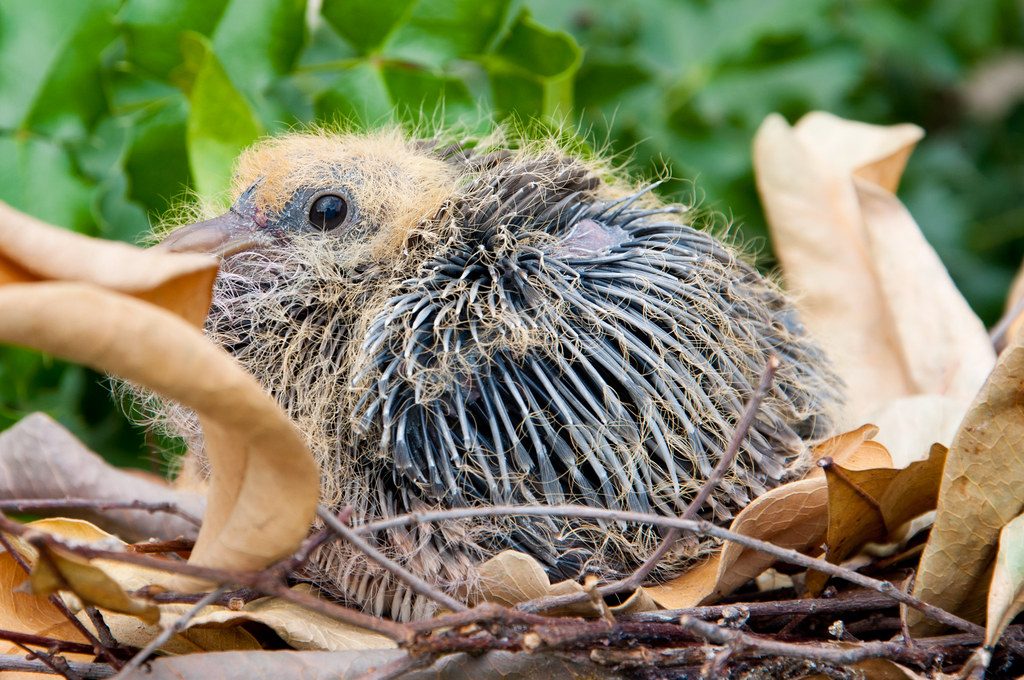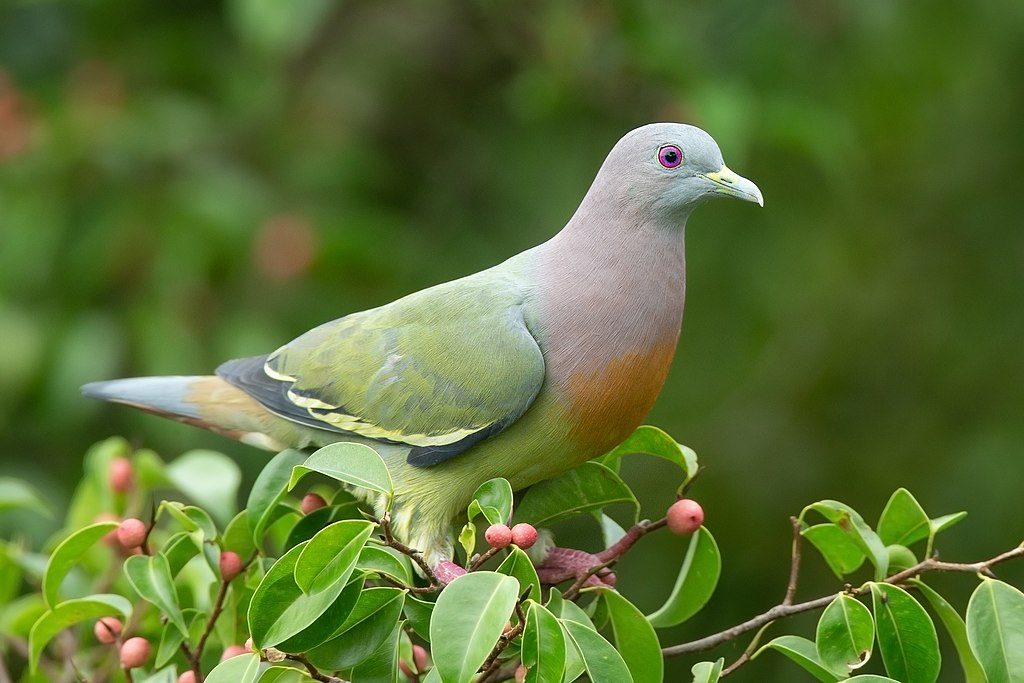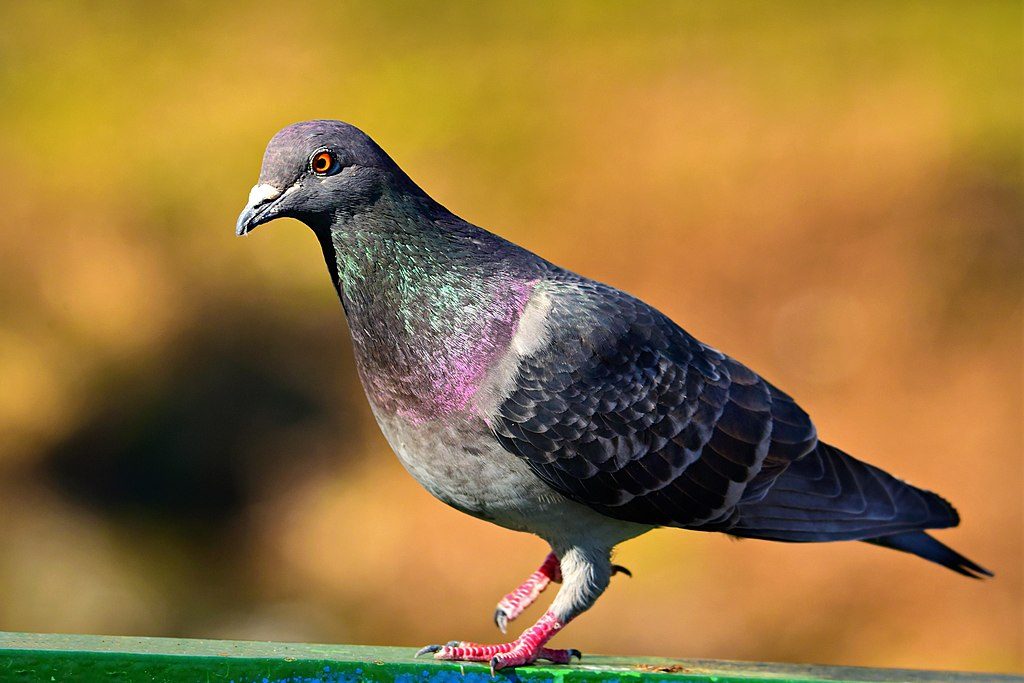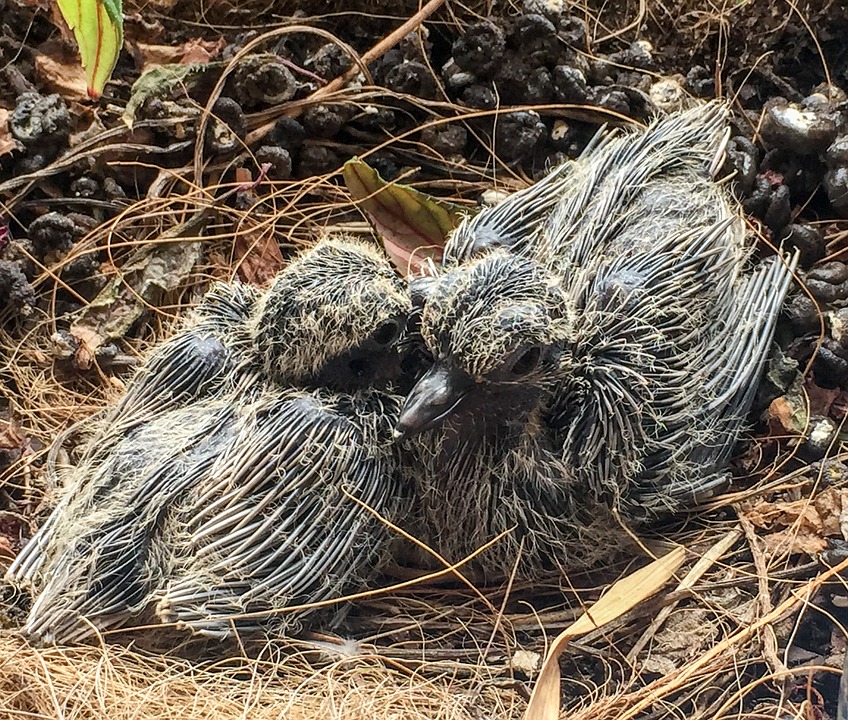All about Birds
Baby Mourning Doves: What you need to know (With Pictures)
Here are the most common questions, answers and everything you need to know about baby mourning doves.
You’ll discover some of the most fascinating facts and must know info about doves that to blow your mind!
Doves and Pigeons

It’s likely that when you walk up the street or wander through the park, you’ll see some doves and pigeons.
These birds are commonly found in both city and rural areas and are usually seen in large flocks.
You may have had a chance encounter with one brave enough to sneak up and grab your dropped piece of sandwich.
For birds that we see almost every day, we probably don’t know all that much about them. I’m going to change that.
This article will cover everything you need to know about these curious feathered-friends.
All About Baby Mourning Doves
These little doves are super cute fluff-balls. There are usually 2 doves per hatch and they each hatch a day apart, with the younger one being slightly bigger than the first.

Baby mourning doves don’t open their mouths as their songbird cousins do.
Food is important to them and they will often be seen poking their beaks into anything in search of food.
They eat by sticking their beaks into their parent’s mouths and lapping up the crop milk.
Doves are very caring parents. They sit on their young to keep them warm and only leave the nest when their babies are big enough to regulate their own temperature.
All About Baby Mourning Doves
Dove babies grow exceedingly fast. By 12 days old they’re big enough to leave their nest and venture into the big wide world.

If they’re over-cautious about leaving their nest then they’ll find themselves hungry, as their parents stop coming to the nest to feed them after this time.
They don’t abandon them completely though, instead, they keep an eye on them from a nearby branch and watch as they eventually leave the nest.
At first, they won’t be able to fly. Instead, they become fledgling birds and will spend the next four days stuck on the ground before they grasp the art of flying.
See Also: The World’s Most Colorful & Beautiful Birds You Must See!
Categories of Ages
Baby mourning doves don’t stay little and adorable for long. They grow up fast and before you know it they’re the size of their parents.
Just as humans go through different stages of development, so do baby mourning doves. From needy babies, stroppy teenagers to fully-fledged adults.
Here are the different stages of development a dove goes through.

Hatchling
These fluffy little baby mourning doves are born with one thing on their minds…food.
Not only do both of the parents take it in turns to incubate the eggs, but they also both produce a rich protein substance in their throats called “crop-milk.”
Nestling
The baby mourning doves can’t regulate their body temperature so one of their parents will sit on them to keep them warm.
When they’ve developed enough to keep themselves warm their parents leave the nest and only visit them to give them food.
Fledgling
At twelve days old the baby mourning doves are old enough to leave the nest. It’ll be around four more days before they learn how to fly, so they’re left vulnerable.
Most baby mourning doves hide in bushes and hedgerows to avoid predators. Their parents continue to feed them, but baby doves are open to many threats.
A good hiding place is crucial for them until they work out how to fly.
A good hiding spot allows their parents to continue feeding them (they can find them by calling them), but the baby mourning dove can stay out of sight from prey such as cats and dogs.
Juvenile

So, they’ve reached their teenage years.
They’re the size of their parents but they’re not fully matured.
They’re nearly an adult but not quite yet! They still have some more learning and developing to do first.
You can tell a juvenile dove apart from adults by the “cere.” This fleshy piece that can be found between the eyes and the base of the bill is pink in juveniles and chalk-white in adults.
The juvenile also makes squeaking sounds (I suppose this is the bird equivalent to a stroppy human teenager).
Adult

They’ve made it to adulthood…and have successfully avoided being eaten by cats and dogs…hurrah!
Adult doves are great at scavenging for food, they enjoy seeds, grains and insects.
They’re expert fliers and they have a harsh cry when they land.
Wild doves can be white, gray or tan, and domestic doves are white or tan.
How to Take Care of a Baby Mourning Dove
So, you’ve found a baby dove and you want to know how to nurse them back to health?
Firstly, make sure that it does, in fact, need your help. If it doesn’t try to run off when you pick it up, then it seems as though it isn’t just a dazed fledgling bird, but it does need some assistance.
Firstly, check around to see if you can find their nest. If it’s a windy day they may have been blown out of their nest.
If you find their nest and you can reach it then you can carefully place them back in it. Picking them up is okay as adult doves won’t disown their babies if they smell of humans.
How to Re-nest a Bird
If you can’t find the baby doves original nest or it’s too high up for you to reach, then you can create a makeshift one to keep them cozy in.
Use a small basket, line it with dried grass and straw and make sure that it has good drainage for those rainy days.
Bright colors may frighten the baby mourning doves, so give the rainbow-colored baskets a miss and stick with neutral shades.
Place your makeshift nest in a tree. Look out for their parents, as they will keep on searching for their baby until they find them. Hopefully, they’ll find them and feed them soon.
How to Check a Baby Dove
Before you re-nest the baby dove, you need to check that they’re well enough to be left in the scary outside world.
Carefully hold them in the palm of your hand, if they feel cold or cool then you need to warm them up.
You can do this by placing them on the low setting of a heat pad or by filling a bottle with warm water and placing it next to the bird.
If, after fifteen minutes the baby dove seems to have brightened up then they’re ready to be re-nested.
How to Feed a Baby Dove
If the baby mourning dove you’ve found appears injured, incapable of looking after themselves, or their parents don’t return to their nest, then it’s best to get them to a rehabilitator.
If you can’t do this, then you need to feed them. You can use different bird formulas such as Gerber and Beechnut strained chicken food.
Make a small snip in the corner of the bag and allow the baby dove to stick their beak into it. They should slurp it up…they will get messy!!!
Make sure that the baby dove is warm before feeding them. If they’re cold then they can’t digest their food properly.
See Also: What do Birds Eat: Attract More Birds With the Best Food
Formula Recipe
Here is a recipe you can follow to feed your rescued dove and pigeon:
Buy some oatmeal and pour out 1.25 measuring cups of it. Microwave 1 cup of shaken, sweet organic soy milk and then add it to the cup. Stir the mixture.
Crack 2 eggs and mix them in to the mixture. If the bird is more mature than just add 1 egg. Use a spoon to mix it up, then top it up with cold soy milk.
The younger they are, the runnier the mixture should be. You can alter the consistency accordingly by adding more or less soy milk.
Storing the Formula
Make sure that the formula is at room temperature before feeding it to your baby dove.
You can store it in the fridge for up to 48 hours. Make sure that your heated mixture is stirred well to avoid their throat being scolded.
Things Not to Do When Feeding Them
Make sure that when you’re feeding your baby dove that you don’t put pressure on the crop when it’s full or partially full.
If the baby dove isn’t fully alert them don’t try and feed them.
Keep the area you’re keeping them in nice and clean.
See Also: Where To Hang Your Hummingbird Feeder
Rehabilitating Them
In many states, it’s illegal to continue looking after a wild bird after you’ve nursed them back to health.
If you believe that the baby mourning dove is now fit and healthy then you should release them back into the wild.
Make sure that you do it in the same area where you found them, and that they have plenty of trees and bushes around them.
Pigeon Facts
Closely linked to doves, pigeons share many similar characteristics.
Like doves do, both of the pigeon parents incubate their eggs and take it in turns to keep them warm. They also hatch 2 eggs in each nest and their babies are fed with “crop milk.”

Pigeon nests are rather flimsy and made up of sticks.
Which isn’t good for those unexpected gusts of winds.
Baby pigeons can fly around 35 days after they’ve hatched.
When they hatch they have pink skin with fluffy yellow down. They open their eyes after 3 to 4 days and view the world for the first time…aw, cute!
All About Carrier Pigeons
Pigeons have excellent navigation skills, are smart birds and skilled fliers. This is why for thousands of years they’ve been used as messenger birds.
Before the telephone was invented it was commonplace to send messages via pigeons. They also played a crucial part in delivering messages during World War 1 and 2.
You can begin training your pigeon from 6 weeks old. Make sure that they have plenty of incentive to return home and increase the distance they travel gradually.
Many scientists believe that pigeons have a magnetic-like field to help them find their way home. It’s like they have their own built-in sat-nav.
Common Problems Faced
by Doves and Pigeons
So, there’s something wrong with your dove or pigeon and you aren’t sure what it is?
Below I’ve listed the most common problems and what to do if you identify this as the issue.
Splayed Legs
This is when their legs haven’t had enough friction to develop property so they now stick out at the sides.
It’s caused by these birds being raised on flat surfaces such as newspaper.
If caught early a hobbling method can fix it. If left too late this can’t be fixed and will cause severe problems for the bird.
This is why it’s always better to re-nest your bird as soon as possible.
Trichominiasis
This is also known as “canker,” and is a white, cottage cheese-like substance found in the throat.
As well as looking unappealing, it’s very dangerous, as if left untreated it will eventually cut off their food supply.
This is a highly contagious disease amongst doves and pigeons and is one of the most common causes for large groups dying.
A medication called Spartrex can cure them, but only if they’re treated in the early stages.
Fascinating Facts About Doves and Pigeons
You can astonish your friends and family with these interesting facts about doves and pigeons.

Neither doves or pigeons have a gallbladder yet both species still produce bile.
Doves are smaller than pigeons, yet their tails are noticeably longer.
Pigeons can beat their wings up to an impressive 10 times per second…now that’s fast! They are also the only bird in the world that can swallow water without lifting their head.
They’re both amazing at adapting to their surroundings. In fact, the only places you’ll struggle to find them are in deserts and the Antarctic.
Fascinating Facts Continued
Pigeons are so good at delivery messages that they have a 95% success rate…sounds better than the mailman!
Doves can have up to 9 broods in 1 year. Now, that’s a lot of babies.
Both doves and pigeons belong to the same family, “Columbidae,” which explains why they have so many physical and behavior characteristics.
The highest known amount ever paid for a carrier pigeon was a whopping $225,000.
FAQs- The Short Answers
Do you still have loads of questions about doves and pigeons? Read on, as I answer the most frequently asked questions, so you can wonder no more.
Question 1 – What is The Symbolism Behind Doves?
A white dove is often used to represent peace, tranquillity and good luck. Many view them as a spiritual messenger, as a symbol of hope and a link between this world and the next.

They’re associated with many goddesses and they represent femininity, procreation and fertility.
Seeing a dove is believed to be a great blessing that shouldn’t be overlooked. If you hear a dove’s call from a dove then good luck is said to be coming your way.
They also symbolize love, happiness and prosperity, which is why they’re released at weddings. Doing so is believed to assure a happy home and eternal love.
Question 2 – How Often Do You Feed a Baby Dove?
You should feed them every two to three hours. Remember, that they won’t be able to digest their food properly if they’re too cold.
Don’t give them water. All the nutrients they need can be found in the baby bird formula.
Question 3 – Should Doves and Pigeons Eat Human Food?

No, they shouldn’t. Doves and pigeons find it hard to digest human food, especially meats.
Pigeons love salt but it doesn’t like them. They need lots of water from their food and salt dehydrates them.
It’s best to feed doves and pigeons seeds and grains.
Question 4 – How Long Does it Take for a Dove and Pigeon Egg to Hatch?
It takes 14 to 15 days for a dove egg to hatch. There are typically two eggs laid and the second is hatched between 20 to 40 hours after the first.
Pigeon eggs take 17 to 19 days to hatch.
Question 5 – Do Doves Abandon Their Babies?
Dove parents are very protective of their young. However, they do show them tough love. When the babies are 12 days old their parents stop coming to the nest to feed them.
It’s a tough world out there and dove parents know that their little ones need to grow up fast.
Once they pluck up the courage to leave their nests they spend around another 4 days facing the dangers on the ground.
Their parents keep a careful eye on them and continue to feed them. They certainly don’t abandon them, but they do persuade them to leave the nest and face the dangerous real world.
Question 6 – Are Doves and Pigeons Smart?
These birds are quiet, smart and sociable. They’re great at sneaking food, flying away in the nick of time and they aren’t overly needy.
They are as smart as they need to be to survive. They’re also clever navigators and with a bit of training can successfully deliver messages.
Question 7 – How Long do Doves Live For?
In the wild a doves average lifespan is one-and-a-half years. They face many dangers from an early age and they’re also prone to contagious diseases such as “canker.”
In captivity a dove can live for around 20 years, which goes to show how detrimental the outside world can be for these wild birds.
Question 8 – Are Pigeons Dirty?
The belief that pigeons are all dirty, disease-ridden creatures is a misconception. They’re actually clean birds, who look after themselves.
They catch diseases like all other species do, but this isn’t due to dirtiness.
Question 9 – Do Doves Return to the Same Nest?

Not only do these loyal birds mate for life, but they also return to their nest year-after-year.
The female dove uses grass, twigs, and sticks to make their nest and it’s usually between 5 and 25 feet from the ground.
Question 10 – Why Are Mourning Doves Called That?
Mourning Doves are seen as a good luck symbol and symbolize peace and love.
They’re called the mourning dove due to the said cooing sound they make. Their sound is often mistaken for that of an owls.
Not only are they adorable looking, but they can also eat up to 20 percent of their body weight every day.
Question 11 – What Does it Mean if You See a Pair of Doves?

Seeing a single dove is considered good luck but seeing a pair of doves together, whether it be in a dream or in front of you, is said to be very symbolic.
A pair of doves represent love, peace, and fidelity. If you see a pair of doves, whether this is in dreamland or in reality, then don’t ignore it.
This is a sign that you should find peace, harmony and balance to your life.
Don’t overlook the significance of seeing this pair of doves, instead take this opportunity to channel this good energy that seeing them brings into enhancing your life.
An Overview to Doves and Pigeons
From cute and fluffy babies to cooing adults, doves and pigeons are fascinating birds that make the wild world far more interesting.
These rulers of the streets, expert scavengers, and curious fliers are valued members of the bird world.
We should never overlook doves and pigeons. They aren’t pests, instead they’re fascinating birds with their own personalities.
Baby doves face so many dangers in the world but they take on all of the challenges that are thrown at them…not bad going for adorable little fluff-balls, is it?

